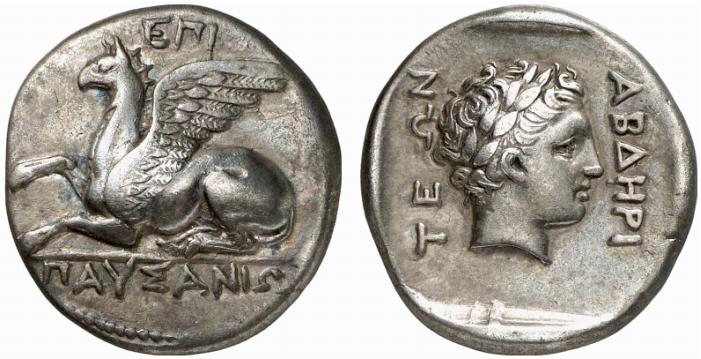Abdera, silver, staters (griffin/Apollo) (386/5-365/60 BCE)
From SILVER
385 BCE - 360 BCE Silver 3,409 kg
Description
| ObverseInscription or printing placed on the obverse.: | ΕΠΙ ΠΑΥΣΑΝΙΟΥ (Greek).ΕΠΙ + monetary name. Griffin sitting left on a line, fore-right paw raised. |
| ReverseInscription or printing placed on the reverse.: | ΑΒΔΗΡΙ-ΤΕΩΝ (Greek).ΑΒΔΗΡΙ-ΤΕΩΝ. Head of Apollo with laurel wreath to the right. The whole in the quadratum incusum |
Mint and issuing power
| MintIdentifies the place of manufacture or issue of a numismatic object.: | Abdera | Ancient regionAncient region.: | Thrace | Modern countryModern country: Greece | AuthorityIdentifies the issuing power. The authority can be "pretended" when the name or the portrait of X is on the coin but he/she was not the issuing power. It can also be "uncertain" when there is no mention of X on the coin but he/she was the issuing power according to the historical sources: |
Chronology
| FromIdentifies the initial date in a range assigned in a numismatic context. | 385 BCE | toIdentifies the final date in a range assigned in a numismatic context.. | 360 BCE | PeriodTime period of the numismatic object.: Classical 480-323 BC |
Physical description
| MetalThe physical material (usually metal) from which an object is made.: | Silver |
Median weightMedian of the weights of numismatic objects (in grams). in grams | 11.25 | DenominationTerm indicating the value of a numismatic object. Examples: tetradrachm, chalkous, denarius.: | stater |
StandardStandard.: |
Image

AC108 Abdera.jpeg [1]
References
| Die study referencePublication of the study: | May 19661May 1966 | ||
| Coin series referenceReference to coin series study: | RQEMAC2RQEMAC, n° 108, HGC 3.23HGC 3.2, 1204 | ||
Obverse dies distribution
| FrequencyFrequency of specimen in distribution. ᵖ | Number of obversesNumber of obverse dies. ᵖ (o) | % (o) | Number of coinsNumber of coins. (n) | % (n) | Die nameName(s) of the die(s). |
| 1 | 4 | 30.77 | 4 | 7.69 | 309, 313, 315, 323 |
| 2 | 2 | 15.38 | 4 | 7.69 | 291, 312 |
| 3 | 1 | 7.69 | 3 | 5.77 | 301 |
| 5 | 2 | 15.38 | 10 | 19.23 | 302, 314 |
| 6 | 1 | 7.69 | 6 | 11.54 | 281 |
| 8 | 2 | 15.38 | 16 | 30.77 | 306, 311 |
| 9 | 1 | 7.69 | 9 | 17.31 | 310 |
| Total | 13 of 13 | 99.98 | 52 of 52 | 100 |
Reverse dies distribution
no distribution is available
Quantification
| Number of obversesNumber of obverse dies. ᵖ (o) | 13 | Number of singletons (o1)The number of singleton coins. ᵖ | 4 |
| Number of reverse diesNumber of reverse dies. (r) | Number of coinsNumber of coins. (n) | 52 | |
| Coins per obverse dieNumber of coins per obverse die. (n/o) | 4 | Coins per reverse dieNumber of coins per reverse die. (n/r) | |
| Reverse per obverse ratioRatio of obverse dies divided by reverse dies. (r/o) | Percentage of singletons (o1)number of coins (n) divided by the number of singletons (o1) ᵖ | 30.77 % | |
| Original number of dies (O) (Carter 1983 formula)The estimation of the number of coins according to Carter 1983 ᵖ | 15.15 | Coins struck if 20,000 as average productivity per dieCoins made if the average productivity for obverses (according to Carter) is 20,000. ᵖ | 303,000 |
| Original number of dies (O) (Esty 2011 formula)The estimation of the number of coins according to the singleton formula in Esty 2011 ᵖ (O) | 17.33 | Survival rate if 20,000 as average productivity per dieSurvival rate if average productivity is 20,000. ᵖ | 0.00017 |
| Coverage (o = % of O) (Esty 1984 formula)Esty 1984 - coverage (% of O) ᵖ (o = % of O) | 92.31% | Die productivity if survival rate 1/2,000Average productivity if survival rate is 1/2,000. ᵖ | 6,864.69 |
| Weight of silver (in kg) if 20,000 coins per die (O = Carter formula)Carter 1983 * Median weight * 20000 (*10 if gold or electrum) ᵖ | 3,409 kg <br /> 3,409 kg | Die productivity if survival rate 1/5,000Average productivity if survival rate is 1/5,000. ᵖ | 17,161.72 |
Remarks
Most likely one single workstation
References
- ^ May, John M F. (1966), The coinage of Abdera (540-345 B.C.), RNS Spec. Publ. 3, London, 268 p., 24 pl.
- ^ Callataÿ, François de (2003), Recueil quantitatif des émissions monétaires archaïques et classiques, Numismatique Romaine, Wetteren, VII + 267 p.
- ^ Hoover, Oliver D. (2017), Handbook of Coins of Macedon and Its Neighbors. 3. Part 2: Thrace, Skythia, and Taurike, Sixth to First Centuries BC, Lancaster-London, xix, 232 p.